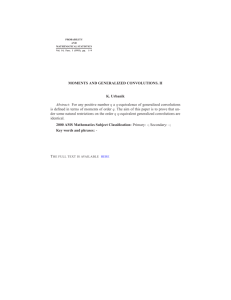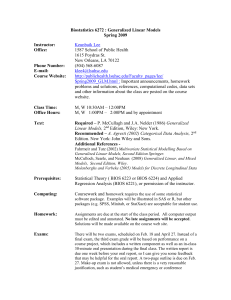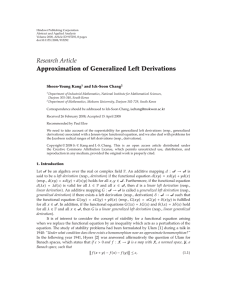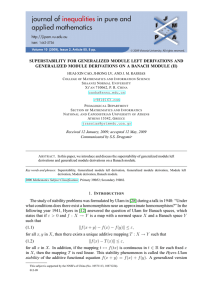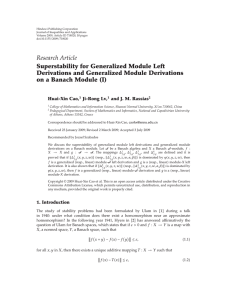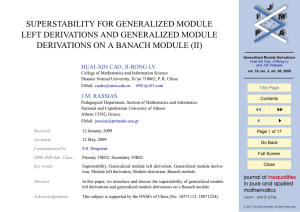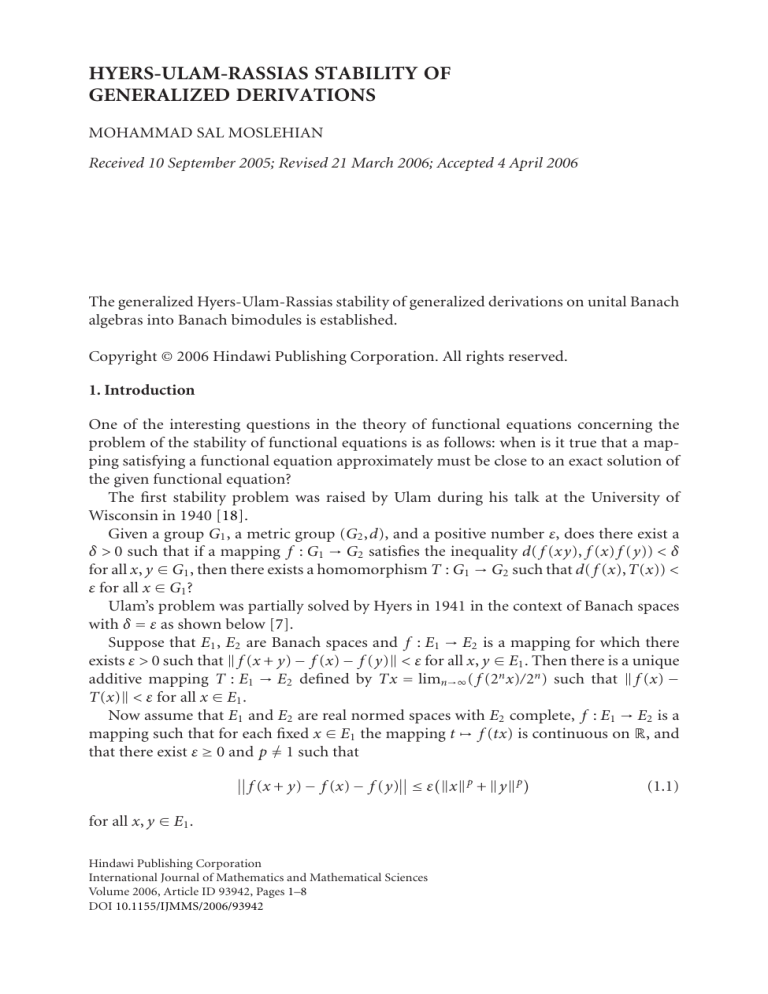
HYERS-ULAM-RASSIAS STABILITY OF
GENERALIZED DERIVATIONS
MOHAMMAD SAL MOSLEHIAN
Received 10 September 2005; Revised 21 March 2006; Accepted 4 April 2006
The generalized Hyers-Ulam-Rassias stability of generalized derivations on unital Banach
algebras into Banach bimodules is established.
Copyright © 2006 Hindawi Publishing Corporation. All rights reserved.
1. Introduction
One of the interesting questions in the theory of functional equations concerning the
problem of the stability of functional equations is as follows: when is it true that a mapping satisfying a functional equation approximately must be close to an exact solution of
the given functional equation?
The first stability problem was raised by Ulam during his talk at the University of
Wisconsin in 1940 [18].
Given a group G1 , a metric group (G2 ,d), and a positive number ε, does there exist a
δ > 0 such that if a mapping f : G1 → G2 satisfies the inequality d( f (xy), f (x) f (y)) < δ
for all x, y ∈ G1 , then there exists a homomorphism T : G1 → G2 such that d( f (x),T(x)) <
ε for all x ∈ G1 ?
Ulam’s problem was partially solved by Hyers in 1941 in the context of Banach spaces
with δ = ε as shown below [7].
Suppose that E1 , E2 are Banach spaces and f : E1 → E2 is a mapping for which there
exists ε > 0 such that f (x + y) − f (x) − f (y) < ε for all x, y ∈ E1 . Then there is a unique
additive mapping T : E1 → E2 defined by Tx = limn→∞ ( f (2n x)/2n ) such that f (x) −
T(x) < ε for all x ∈ E1 .
Now assume that E1 and E2 are real normed spaces with E2 complete, f : E1 → E2 is a
mapping such that for each fixed x ∈ E1 the mapping t → f (tx) is continuous on R, and
that there exist ε ≥ 0 and p = 1 such that
f (x + y) − f (x) − f (y) ≤ ε x p + y p
for all x, y ∈ E1 .
Hindawi Publishing Corporation
International Journal of Mathematics and Mathematical Sciences
Volume 2006, Article ID 93942, Pages 1–8
DOI 10.1155/IJMMS/2006/93942
(1.1)
2
Hyers-Ulam-Rassias stability of generalized derivations
It was shown by Rassias [15] for p ∈ [0,1) (and indeed p < 1) and Gajda [4] following
the same approach as in [15] for p > 1 that there exists a unique linear map T : E1 → E2
such that
f (x) − T(x) ≤ 2ε x p
2 p − 2
(1.2)
for all x ∈ E1 . This phenomenon is called Hyers-Ulam-Rassias stability. It is shown that
there is no analogue of Rassias result for p = 1 (see [4, 17]).
In 1994, a generalization of the Rassias theorem was obtained by Găvruţa as follows
[5].
Suppose (G,+) is an abelian group, E is a Banach space, and that the so-called admissible control function ϕ : G × G → [0, ∞) satisfies
∞
ϕ(x,
y) :=
1 −n n n 2 ϕ 2 x,2 y < ∞
2 n =0
(1.3)
for all x, y ∈ G. If f : G → E is a mapping with
f (x + y) − f (x) − f (y) ≤ ϕ(x, y)
(1.4)
for all x, y ∈ G, then there exists a unique mapping T : G → E such that T(x + y) = T(x) +
for all x, y ∈ G.
T(y) and f (x) − T(x) ≤ ϕ(x,x)
Since then several stability problems of various functional equations have been investigated by many mathematicians. The reader is referred to [3, 16] for a comprehensive
account of the subject.
Generalized derivations first appeared in the context of operator algebras [8]. Later,
these were introduced in the framework of pure algebra [6]. There is also another generalization of the notion of derivation which is called (σ,τ)-derivation (cf. [9]).
Let Ꮽ be an algebra and let ᐄ be an Ꮽ-bimodule. A linear mapping μ : Ꮽ → ᐄ is called
a generalized derivation if there exists a derivation (in the usual sense) δ : Ꮽ → ᐄ such that
μ(ab) = aμ(b) + δ(a)b for all a,b ∈ Ꮽ. Familiar examples are the derivations from Ꮽ to ᐄ
and all so-called inner generalized derivations; those are defined by μx,y (a) = xa − ay for
fixed arbitrary elements x, y ∈ ᐄ. Moreover, every right multiplier (i.e., an additive map
h of Ꮽ satisfying h(ab) = ah(b) for all a,b ∈ Ꮽ) is a generalized derivation.
The stability of derivations was studied by Park in [13, 14]. A discussion of the stability of the so-called (σ − τ)-derivations and a study of the so-called generalized (θ,φ)derivations are given in [2, 11], respectively. The present paper is devoted to the study of
the stability of generalized derivations. The results of this paper are a generalization of
those of Park’s papers [13, 14].
Throughout the paper, A denotes a unital normed algebra with unit 1 and ᐄ is a unitlinked Banach Ꮽ-bimodule in the sense that 1x = x1 = x for all x ∈ ᐄ.
2. Main results
Our aim is to establish the generalized Hyers-Ulam-Rassias stability of generalized derivations. We extend main results of Park [14] to generalized derivations from a unital
Mohammad Sal Moslehian 3
normed algebra to a unit linked Banach Ꮽ-bimodule. We apply the direct method which
was first devised by Hyers [7] to construct an additive function from an approximate one
and use some ideas of [11, 13].
Theorem 2.1. Suppose f : Ꮽ → ᐄ is a mapping with f (0) = 0 for which there exist a map
g : Ꮽ → ᐄ and a function ϕ : Ꮽ × Ꮽ × Ꮽ × Ꮽ → [0, ∞) such that
∞
ϕ(a,b,c,d)
:=
1 −n n
2 ϕ 2 a, 2n b, 2n c, 2n d < ∞,
2 n =0
f (λa + λb + cd) − λ f (a) − λ f (b) − c f (d) − g(c)d ≤ ϕ(a, b, c, d)
(2.1)
(2.2)
for all λ ∈ T = {λ ∈ C : |λ| = 1} and all a,b,c,d ∈ Ꮽ. Then there exists a unique generalized
derivation μ : Ꮽ → ᐄ such that
f (a) − μ(a) ≤ ϕ(a,a,0,0)
(2.3)
for all a ∈ Ꮽ.
Proof. Setting c = d = 0 and λ = 1 in (2), we have
f (a + b) − f (a) − f (b) ≤ ϕ(a, b, 0, 0)
(2.4)
for all a,b ∈ Ꮽ. Now we use the Rassias method on inequality (2.4) (see [5, 10]). One can
use induction on n to show that
n −1
f 2 a
1 n
≤
−
f
(a)
2−k ϕ 2k a,2k a,0,0
2n
2
(2.5)
k =0
for all n ∈ N and all a ∈ Ꮽ, and that
n n
−1
f 2 a
f 2m a 1
2−k ϕ 2k a,2k a,0,0
2n − 2m ≤ 2
(2.6)
k =m
for all n > m and all a ∈ Ꮽ. It follows from the convergence (2.1) that the sequence
{ f (2n a)/2n } is Cauchy. Due to the completeness of ᐄ, this sequence is convergent. Set
f 2n a
μ(a) := lim
.
n→∞
2n
(2.7)
Putting c = d = 0 and replacing a, b by 2n a, 2n b, respectively, in (2.2), we get
−n n
2 f 2 (λa + λb) − 2−n λ f 2n a − 2−n λ f 2n b ≤ 2−n ϕ 2n a,2n b,0,0
(2.8)
4
Hyers-Ulam-Rassias stability of generalized derivations
Taking the limit as n → ∞ we obtain
μ(λa + λb) = λμ(a) + λμ(b)
(2.9)
for all a,b ∈ Ꮽ and all λ ∈ T.
Next, let γ = θ1 + iθ2 ∈ C where θ1 ,θ2 ∈ R. Let γ1 = θ1 − [θ1 ], let γ2 = θ2 − [θ2 ]. Then
0 ≤ γi < 1, (1 ≤ i ≤ 2) and by using [12, Remark 2.2.2] one can represent γi as γi = (λi,1 +
λi,2 )/2 in which λi, j ∈ T (1 ≤ i, j ≤ 2). Since μ satisfies (2.9) we infer that
μ(γx) = μ θ1 x + iμ θ2 x
= θ1 μ(x) + μ γ1 x + i θ2 μ(x) + μ γ2 x
1 1 θ1 μ(x) + μ λ1,1 x + λ1,2 x + i θ2 μ(x) + μ λ2,1 x + λ2,2 x
2
2
1
1
1
1
= θ1 μ(x) + λ1,1 μ(x) + λ1,2 μ(x) + i θ2 μ(x) + λ2,1 μ(x) + λ2,2 μ(x)
2
2
2
2
= θ1 μ(x) + iθ2 μ(x) = γμ(x)
(2.10)
=
for all x ∈ Ꮽ. So μ is C-linear.
for all a ∈
Moreover, it follows from (2.5) and (2.7) that f (a) − μ(a) ≤ ϕ(a,a,0,0)
Ꮽ. It is known that additive mapping μ satisfying (2.3) is unique [1].
Putting λ = 1, a = b = 0, and replacing c, d by 2n c, 2n d, respectively, in (2.2) we obtain
2n f 2 cd − 2n c f 2n d − 2n g 2n c d ≤ ϕ 0, 0, 2n c, 2n d ,
(2.11)
whence
−2n 2n 2
f 2 cd − 2−n c f 2n d − 2−n g 2n c d ≤ 2−2n ϕ 0,0,2n c,2n d .
(2.12)
Put d = 1 in (2.12). By (2.7), limn→∞ 2−2n f (22n a) = μ(a) and by the convergence of series
(2.1), limn→∞ 2−2n ϕ(0,0,2n c,2n d) = 0. Hence the sequence {2−n g(2n c)} is convergent. Set
δ(c) := limn→∞ 2−n g(2n c), c ∈ Ꮽ. Let n tend to ∞ in (2.12). Then
μ(cd) = cμ(d) + δ(c)d.
(2.13)
Next we claim that δ is a derivation. Put d = 1 in (2.13). Then δ(c) = μ(c) − cμ(1).
Hence δ is linear. Further,
δ c1 c2 = μ c1 c2 − c1 c2 μ(1)
= c1 μ c2 + δ c1 c2 − c1 c2 μ(1)
= c1 μ c2 + μ c1 − c1 μ(1) c2 − c1 c2 μ(1)
= c1 μ c2 − c2 μ(1) + μ c1 − c1 μ(1) c2
= c1 δ c2 + δ c1 c2 .
(2.14)
Thus δ satisfies the Leibnitz rule. It then follows from (2.13) that μ is a generalized
derivation.
Mohammad Sal Moslehian 5
Remark 2.2. The significance of functional equation (2.2) is that the required derivation
δ is naturally constructed. In other words, we do not need any additional functional
inequality for existence of δ.
Remark 2.3. As Ꮽ is unital, the mapping δ that appeared in the definition of generalized
derivation is unique. In fact, δ(a) = μ(a) − aμ(1).
Corollary 2.4. Suppose that f : Ꮽ → ᐄ is a mapping with f (0) = 0 for which there exist
constants β ≥ 0 and 0 < p < 1 such that
f (λa + λb + cd) − λ f (a) − λ f (b) − c f (d) − g(c)d ≤ β a p + b p + c p + d p
(2.15)
for all λ ∈ T and all a,b,c,d ∈ Ꮽ.
Then there is a unique generalized derivation μ : Ꮽ → ᐄ such that
p
f (a) − μ(a) ≤ βa
1 − 2 p −1
(2.16)
for all a ∈ Ꮽ.
Proof. Put ϕ(a,b,c,d) = β(a p + b p + c p + d p ) in Theorem 2.1.
Proposition 2.5. Suppose that f : Ꮽ → ᐄ is a mapping with f (0) = 0 for which there exists
a function ϕ : Ꮽ × Ꮽ × Ꮽ × Ꮽ → [0, ∞) such that
∞
ϕ(a,b,c,d)
:=
1 −n n n n n 2 ϕ 2 a,2 b,2 c,2 d < ∞,
2 n =0
f (λa + λb + cd) − λ f (a) − λ f (b) − c f (d) − g(c)d ≤ ϕ(a,b,c,d)
(2.17)
for λ = 1,i and for all a,b,c,d ∈ Ꮽ. If for each fixed a ∈ Ꮽ the function t → f (ta) is continuous on R, then there exists a unique generalized derivation μ : Ꮽ → ᐄ such that f (a) −
μ(a) ≤ ϕ(a,a,0,0)
for all a ∈ Ꮽ.
Proof. Put c = d = 0 and λ = 1 in (2.2). It follows from the proof of Theorem 2.1 that
there exists a unique additive mapping μ : Ꮽ → ᐄ given by μ(a) = limn→∞ ( f (2n a)/2n ),
a ∈ Ꮽ. By the same reasoning as in the proof of the theorem of [15], the mapping μ is
R-linear.
Assuming b = c = d = 0 and λ = i, it follows from (2.2) that f (ia) − i f (a) ≤
ϕ(a,0,0,0), a ∈ Ꮽ. Hence (1/2n ) f (2n ia) − i f (2n a) ≤ ϕ(2n a,0,0,0) for all n ∈ N and
a ∈ Ꮽ. The right-hand side tends to zero as n → ∞ so that
μ(ia) = lim
n→∞
f 2n ia
i f 2n a
= lim
= iμ(a)
n
n→∞
2
2n
(2.18)
for all a ∈ Ꮽ. For each λ ∈ C, λ = r1 + ir2 (r1 ,r2 ∈ R). Hence
μ(λa) = μ r1 a + ir2 a = r1 μ(a) + r2 μ(ia)
= r1 μ(a) + ir2 μ(a) = r1 + ir2 μ(a) = λμ(a).
(2.19)
6
Hyers-Ulam-Rassias stability of generalized derivations
Thus μ is C-linear. The fact that μ is a generalized derivation can be deduced in the same
fashion as in the proof of Theorem 2.1.
Proposition 2.6. Let Ꮽ be a unital C ∗ -algebra. Suppose that f : Ꮽ → ᐄ is a mapping with
f (0) = 0 for which there exists a function ϕ : Ꮽ × Ꮽ × Ꮽ × Ꮽ → [0, ∞) such that
∞
ϕ(a,b,c,d)
:=
1 −n n n n n 2 ϕ 2 a,2 b,2 c,2 d < ∞,
2 n =0
f (λa + λb + cd) − λ f (a) − λ f (b) − c f (d) − g(c)d ≤ ϕ(a,b,c,d),
(2.20)
n ∗
f 2 u − f 2n u ∗ ≤ ϕ 2n u,2n u,0,0
for all λ ∈ T, all a,b,c,d ∈ Ꮽ, all nonnegative integers n, and all unitaries u in Ꮽ. Then there
for
exists a unique generalized derivation μ : Ꮽ → ᐄ such that f (a) − μ(a) ≤ ϕ(a,a,0,0)
all a ∈ Ꮽ.
Proof. It follows from the proof of Theorem 2.1 that there exists a unique generalized
derivation μ : Ꮽ → ᐄ given by μ(a) = limn→∞ ( f (2n a)/2n ), a ∈ Ꮽ satisfying (2.3).
Using (2.20), we have
−n n ∗ 2 f 2 u − 2−n f 2n u ∗ ≤ 2−n ϕ 2n u,2n u,0,0 .
(2.21)
Letting n → ∞ we conclude that μ(u∗ ) = μ(u)∗ . Since μ is linear and every element of a
C ∗ -algebra can be represented as a linear combination of unitaries [12], we deduce that
μ(a∗ ) = μ(a)∗ .
Now let Ꮽ be a unital Banach algebra. The mapping f : Ꮽ → Ꮽ is called an approximately generalized derivation if f (0) = 0 and there exist a positive number ε and a mapping g : Ꮽ → Ꮽ such that
f (λa + λb + cd) − λ f (a) − λ f (b) − c f (d) − g(c)d ≤ ε
(2.22)
for all λ ∈ T and all a,b,c,d ∈ Ꮽ.
Theorem 2.7. Let Ꮽ be a unital Banach algebra and let f : Ꮽ → Ꮽ be an approximately
generalized derivation with the corresponding mapping g. Then f is a generalized derivation
and g is a derivation.
Proof. Put ϕ(a,b) = ε in Theorem 2.1. Then we get a generalized derivation μ defined by
μ(a) := limn→∞ ( f (2n a)/2n ) such that
μ(a) − f (a) ≤ ε
(2.23)
Mohammad Sal Moslehian 7
for all a ∈ Ꮽ. We have
n m 2 f 2 a − 2m f (a) ≤ 2n 1 f 2m a − g 2n 1 2m a − f 2n 1 2m a + f 2n 1 2m a − g 2n 1 2m a − 2n+m 1 f (a)
≤ ε + f 2n 1 2m a − g 2n 1 2m a − 2n+m 1 f (a)
≤ ε + f 2n 1 2m a − μ 2n 1 2m a + μ 2n 1 2m a − 2n+m 1 f (a) − g 2n 1 2m a
(2.24)
≤ 2ε + μ 2n 1 2m a − 2n+m 1 f (a) − g 2n 1 2m a
≤ 2ε + 2m μ 2n 1a − f 2n 1a + 2m f 2n 1a − 2n 1 f (a) − g 2n 1 a
≤ 2 + 2m+1 ε
for all nonnegative integers m, n and all a ∈ Ꮽ. Fix m and let n tend to ∞ in the following
inequality:
m+1
m f 2 a − 2m f (a) ≤ 2 + 2
ε.
2n
(2.25)
Then f (2m a) = 2m f (a) for all m and all a ∈ Ꮽ. Therefore μ(a) = limm→∞ ( f (2m a)/2m ) =
f (a) for all a ∈ Ꮽ.
Acknowledgment
The author would like to thank the referees for their useful comments.
References
[1] C. Baak and M. S. Moslehian, On the stability of J ∗ -homomorphisms, Nonlinear Analysis. Theory,
Methods & Applications 63 (2005), no. 1, 42–48.
, Generalized (θ,φ)-derivations on Banach algebras, preprint.
[2]
[3] S. Czerwik (ed.), Stability of Functional Equations of Ulam-Hyers-Rassias Type, Hadronic Press,
Florida, 2003.
[4] Z. Gajda, On stability of additive mappings, International Journal of Mathematics and Mathematical Sciences 14 (1991), no. 3, 431–434.
[5] P. Găvruţa, A generalization of the Hyers-Ulam-Rassias stability of approximately additive mappings, Journal of Mathematical Analysis and Applications 184 (1994), no. 3, 431–436.
[6] B. Hvala, Generalized derivations in rings, Communications in Algebra 26 (1998), no. 4, 1147–
1166.
[7] D. H. Hyers, On the stability of the linear functional equation, Proceedings of the National Academy of Sciences of the United States of America 27 (1941), 222–224.
[8] M. Mathieu (ed.), Elementary Operators & Applications, World Scientific, New Jersey, 1992, Proceedings of the International Workshop.
[9] M. Mirzavaziri and M. S. Moslehian, Automatic continuity of σ-derivations in C ∗ -algebras, to
appear in Proceedings of the American Mathematical Society.
8
Hyers-Ulam-Rassias stability of generalized derivations
[10] M. S. Moslehian, Approximately vanishing of topological cohomology groups, Journal of Mathematical Analysis and Applications 318 (2006), no. 2, 758–771.
, Approximate (σ − τ)-contractibility, to appear in Nonlinear Functional Analysis and
[11]
Applications.
[12] G. J. Murphy, C ∗ -Algebras and Operator Theory, Academic Press, Massachusetts, 1990.
[13] C.-G. Park, Lie ∗ -homomorphisms between Lie C ∗ -algebras and Lie ∗-derivations on Lie C ∗ algebras, Journal of Mathematical Analysis and Applications 293 (2004), no. 2, 419–434.
, Linear derivations on Banach algebras, Nonlinear Functional Analysis and Applications
[14]
9 (2004), no. 3, 359–368.
[15] Th. M. Rassias, On the stability of the linear mapping in Banach spaces, Proceedings of the American Mathematical Society 72 (1978), no. 2, 297–300.
[16] Th. M. Rassias (ed.), Functional Equations, Inequalities and Applications, Kluwer Academic, Dordrecht, 2003.
[17] Th. M. Rassias and P. Šemrl, On the behavior of mappings which do not satisfy Hyers-Ulam stability, Proceedings of the American Mathematical Society 114 (1992), no. 4, 989–993.
[18] S. M. Ulam, Problems in Modern Mathematics, chapter VI, Science Editions, John Wiley & Sons,
New York, 1964.
Mohammad Sal Moslehian: Department of Mathematics, Ferdowsi University, P.O. Box 1159,
Mashhad 91775, Iran; Banach Mathematical Research Group (BMRG), Mashhad, Iran
E-mail address: moslehian@ferdowsi.um.ac.ir



